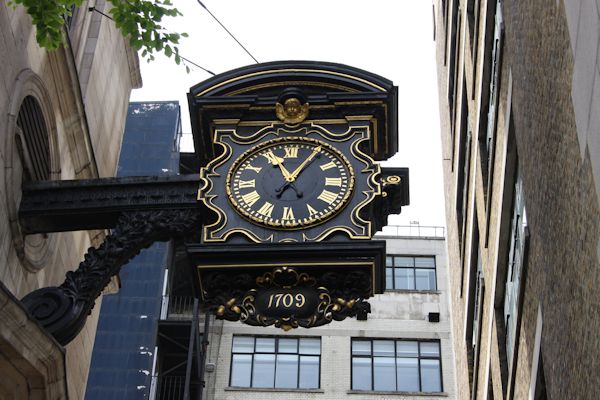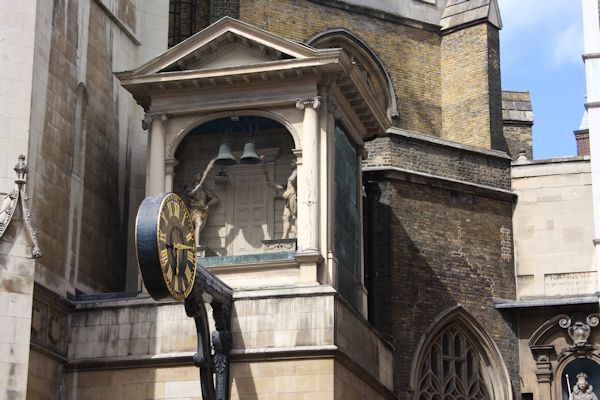Little Boy Lost

The church of St Magnus was rebuilt in 1676, by Wren, after being one of the first buildings destroyed by the great fire of London. It was said to be one of Wrenís finest works. The tower has an octagonal lantern, crowned by a cupola and short spire, picturesque and effective. The arch beneath once formed the approach road to London Bridge, which in 1760 had to be widen due to increased traffic. This possibility had fortunately been foreseen by Wren, so when widening was needed it was completed without any difficulty, although it has injured an otherwise beautiful building. The carved clock projecting from the tower was erected in 1709, at a cost of £485, being donated by Sir Charles Duncombe, in fulfilment of a vow he once made. When as a poor young boy, Duncombe was left for some considerable time, waiting in a cart for his master to arrive on London Bridge, lost from his employer for not knowing the hour; he promised he would donate a clock to St Magnus, if he ever became rich.
A Boy and Two Giantís
Two giants striking a church clock bell were a magnet for pick-pockets and the childhood obsession for a small boy. These enormous figures have been looking down on busy Fleet Street for almost three and a half centuries, with an intervening century respite in the seclusion of a villa in Regentís Park.
St Dunstan-in-the-west was built on the north side of Fleet Street during the tenth century. St Dunstanís survived the Great Fire of London in 1666, with the determination of the Dean of Westminster and forty young school boys on bucket patrol. Although the building was saved from the fire the original clock or ďdyallĒ as it was called, was badly scorched. Although it still kept time, it became difficult to see the clock face from any distance.
Thomas Harrys, a clockmaker from nearby Water Lane, approached the church authorities about making a new timepiece. He offered a new clock complete with two figures to beat the bell for £80, but eventually settled on £35, although it is said that he scaled back his original plan. The new clock started measuring time from 28 October 1671 onwards after the removal of the old one.
A rather young and mischievous child who often played-up his nursemaid was taken one day to watch the giants beating the bell at St Dunstanís; she found this calmed the boyís bad behaviour. The visits were made into a regular treat, a reward for his less disruptive nature. One day while he stood watching the giants tolling the hour with his nursemaid, he boasted that when he grew-up and became a man, he would buy those giants for his own home.
In 1830 it was decided to demolish the old St Dunstanís in favour of road widening and the replacement church was set thirty feet back. It was arranged to auction the clock and its giants and the highest bidder was the Marquis of Hertford Ė the little boy who had vowed to one day to own it!
After paying the £200 guineas (£220) for his beloved timepiece, he had it removed to his villa in Regentís Park. Built by Decimus Burton on six acres of Regentís Park, the new villa had the clock and giants refurbished and installed on the front garden of the villa which he named St Dunstanís Lodge, in their honour.
For a century the giants remained in Regentís Park, striking the quarter hour for successive the residents of the villa. During the First World War, St Dunstanís Lodge was loaned to the Blinded Soldiersí and Sailorsí and for many years the charity was known simply as St Dunstanís.
In 1935, on the occasion of the Silver Jubilee of King George V, the new owner of the villa Lord Rothermere, the newspaper publisher, return the giants and their clock back to St Dunstanís Church, where they remain to this day.
A year later the villa was sold to Barbara Hutton, the heiress of the Woolworth fortune and renamed Winfield House, Hutton eventually gave the building to the United States Government and you know it today as the American Ambassadorís residence.
London Time

Follow Us
The contents of this website are the property of knowledgeoflondon.com and therefore must not be reproduced without permission. Every effort is made to ensure the details contained on this website are correct, however, we cannot accept responsibility for errors and omissions.
© Copyright 2004 -
Contact Us | Advertise